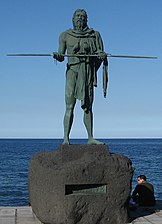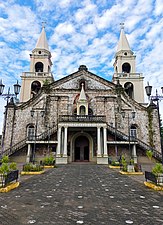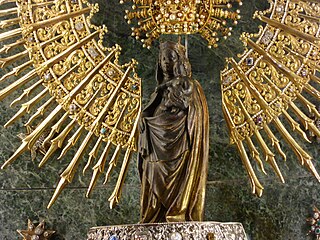
Our Lady of the Pillar is the name given to the Blessed Virgin Mary in the context of the traditional belief that Mary, while living in Jerusalem, supernaturally appeared to the Apostle James the Greater in AD 40 while he was preaching in what is now Spain. Those who adhere to this belief consider this appearance to be the only recorded instance of Mary exhibiting the mystical phenomenon of bilocation. Among Catholics, it is also considered the first Marian apparition, and unique because it happened while Mary was still living on Earth.

Candelaria, also Villa Mariana de Candelaria, is a municipality and city in the eastern part of the island of Tenerife in the Province of Santa Cruz de Tenerife, in the Canary Islands, Spain. The city is located on the coast, 17 km southwest of Santa Cruz de Tenerife. The population is 25,140 (2010), and the area is 49.18 km².

Candlemas, also known as the Feast of the Presentation of Jesus Christ, the Feast of the Purification of the Blessed Virgin Mary, or the Feast of the Holy Encounter, is a Christian feast day commemorating the presentation of Jesus at the Temple by Joseph and Mary. It is based upon the account of the presentation of Jesus in Luke 2:22–40.
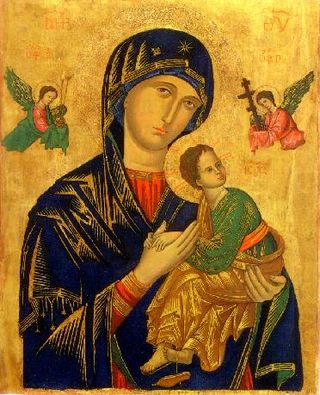
A patronage of the Blessed Virgin Mary is a form of spiritual protection attributed to Mary, mother of Jesus, in favor of some occupations, activities, religious orders, congregations, dioceses, and geographic locations.
Alonso de Espinosa was a Spanish priest and historian of the sixteenth century. He was the first official historian of the island of Tenerife.

The Diocese of San Cristóbal de La Laguna, also called Diocese of Tenerife or Diocese Nivariense, is a diocese located in the city of San Cristóbal de La Laguna in the Canary Islands and a suffragan in the ecclesiastical province of the Archdiocese of Sevilla in Spain. The diocese includes the islands of Tenerife, La Palma, La Gomera and El Hierro, in the province of Santa Cruz de Tenerife. The seat has been vacant since 16 September, 2024.
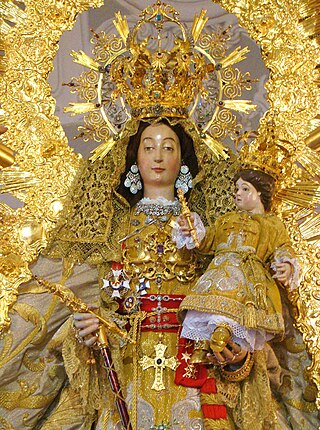
The Virgin of Los Remedios or Our Lady of Los Remedios is a title of the Virgin Mary developed by the Trinitarian Order, founded in the late 12th century. The devotion became tied to the Reconquista of Spain, then still at its height. In the following century it spread to other parts of Europe. When Spain began the exploration and conquest of the Americas, it was a favorite devotion of the Spanish conquistadores. It remains a popular devotion in Spain and Latin America.

"Bajada" is the shortened version of the Fiestas de la Bajada which is a festival which takes place in several places in the Canary Islands. Bajada is Spanish for "bringing down", and means the bringing of a patron saint's statue from its normal place in a chapel to be celebrated by the people.

The National Shrine of the Our Lady of Candles, also known as the Metropolitan Cathedral of Saint Elizabeth of Hungary and colloquially as Jaro Cathedral, is a cathedral located in the district of Jaro in Iloilo City, on the island of Panay in the Philippines. The seat of the Roman Catholic Archdiocese of Jaro, it was placed under the patronage of Saint Elizabeth of Hungary. It was established in 1575 as a visita (chapel-of-ease) of Oton by the Augustinians and as a separate parish in 1587. The present-day structure of Jaro Cathedral was built in 1874.

The Basilica of the Royal Marian Shrine of Our Lady of Candelaria is a Roman Catholic minor basilica, the first Marian shrine of the Canary Islands, located in the municipality and city of Candelaria on the island of Tenerife. It is located some 20 km (12 mi) south of the island's capital, Santa Cruz de Tenerife.

The Cathedral of San Cristóbal de La Laguna or Catedral de Nuestra Señora de los Remedios is a Catholic church in Tenerife, Spain. Constructed between 1904 and 1915 to replace an earlier building begun in 1515 and designated a cathedral in 1818, it is dedicated to the Virgin of Los Remedios. The cathedral is the mother church of the diocese, which includes the islands of Tenerife, La Palma, La Gomera and El Hierro in the province of Santa Cruz de Tenerife. It is therefore where the episcopal seat of the bishop of this diocese, which is currently vacant following the 2024 retirement of Bishop Bernardo Álvarez Afonso. This is one of the most important churches of the Canary Islands.

Our Lady of Peñafrancia is an image of the Blessed Virgin Mary. A Marian image is permanently enshrined in the Minor Basilica of Our Lady of Peñafrancia in Naga, Camarines Sur.

Cueva de Achbinico, also called cave of San Blas is a Roman Catholic church and cave located in Candelaria, Tenerife, Canary Islands (Spain).
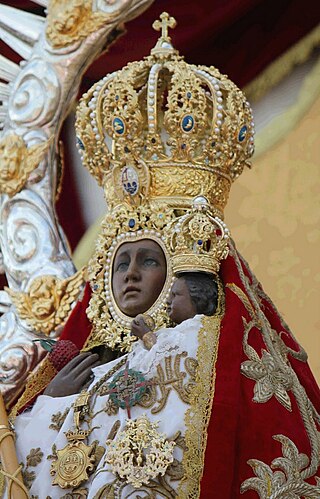
Our Lady of Cabeza is a Marian apparition and statue of the Madonna and Child, whose cult is centered at the Basilica of Nuestra Señora de la Cabeza, located in the Natural Park of the Sierra of Andújar, 32 km north of the city of Andújar, Spain. A Black Madonna, she is known popularly as La Morenita.

The Our Lady of Guidance is a title of the Blessed Virgin Mary associated with a 16th-century Marian image depicted as the Immaculate Conception and widely venerated by Filipinos. The wooden Black Madonna is considered the oldest extant Marian statue in the Philippines. Locally venerated as patroness of navigators and travelers, the image is enshrined at the Ermita Church in the city of Manila.
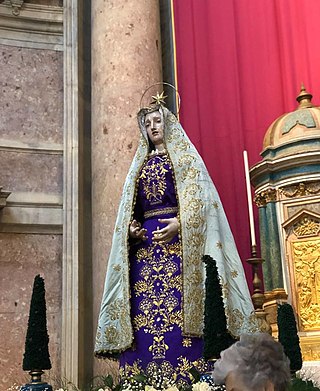
Our Lady of Solitude is a title of Mary, mother of Jesus and a special form of Marian devotion practised in Spanish-speaking countries to commemorate the solitude of Mary on Holy Saturday. Variant names include Nuestra Señora de la Soledad, Maria Santisima, Nuestra Señora Dolorosisima de la Soledad, and Virgen de la Soledad.
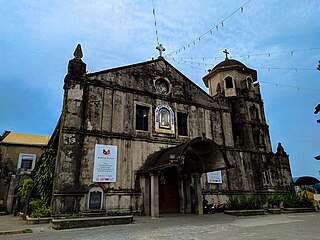
The Diocesan Shrine and Parish of Our Lady of Candelaria, commonly known as Silang Church, is a Roman Catholic parish church in the municipality of Silang, in the province of Cavite, Philippines under the Diocese of Imus. Its titular is the Our Lady of Candelaria. The church is known for its Spanish colonial architectural style and the rococo-influenced retablos. It is the oldest existing stone church in the province of Cavite, having been completed in 1639.

La Virgen de los Remedios de Pampanga also known as Indu ning Capaldanan, Tula ning Kapampangan is a Marian title of the Blessed Virgin Mary venerated by Capampangan Catholics as the official patroness of Pampanga, Philippines.

Nuestra Señora de la Purificación y la Candelaria is a venerated image of the Blessed Virgin Mary enshrined in Jaro Cathedral and the patroness of Western Visayas.

Our Lady of Regla, otherwise known as Our Lady of the Rule and The Virgin of Regla, is a Marian apparition of the Catholic Church venerated in various Hispanic countries such as: Cuba, the Dominican Republic, and Spain. In contrast to other Marian apparitions, she is typically depicted with dark skin.












